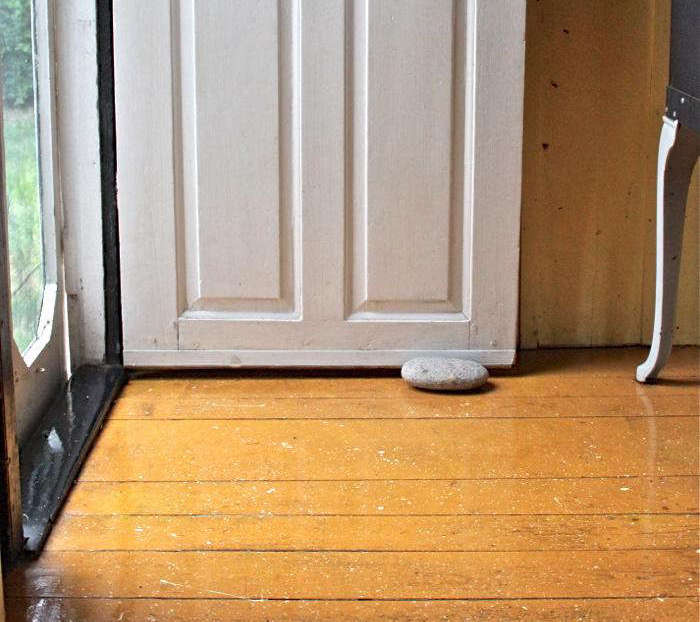My boyfriend works as a professional art handler, which sometimes involves painting museum walls to seamless perfection. When I decided to paint a wardrobe for our apartment last month, he kindly let me flail away with a roller for a few hours (doing it my way) before he politely asked if he could give me a few pointers. Who knew there was so much technique involved?
Here are a few tricks to try next time you’re using a paint roller.

1. Get double use of your paint tray.
Before you begin, cover your paint tray with a plastic grocery bag or trash bag and tape the bag tightly in place. Then, use the tray as you normally would. This allows for easy clean-up: just let any paint remnants dry, then take the bag off and throw it out. Plus, you’ll get double (or triple) use out of one paint tray.
2. De-fuzz your roller.
Pick off any loose fuzz from your roller cover before you begin, or give it a once-over with some painter’s tape, to avoid loose fuzz getting stuck in your paint. Alternatively, you can give your roller cover a wash in plain water with some liquid soap, and rinse well.

3. Be sure you have enough paint.
After a few hours of painting my wardrobe, my thumb and wrist were getting sore. Turns out, the problem was too little paint on my roller, which meant I had to push hard to roll the thin amount of paint onto the surface. (Another tell-tale sign that you’re using too little paint: flattened, matted-down nap on your roller cover.)
Painting shouldn’t be that hard. When it comes to getting paint on your roller, you’re going for the perfect happy medium: definitely not too little, and definitely not too much (you do not want it to be dripping). There should be enough paint to cover the roller evenly so that it looks wet—think “ample.”

4. Practice the art of the roller spin.
The secret to getting an even coat on your roller? Spinning it.
Here’s how:
- First, pour a generous amount of paint into the flat “well” of the paint tray.
- Then, dip your roller into the paint and roll it just a bit, so that you pick up a good amount of paint.
- Run the roller over the ridged, slanted part of the paint tray—fast, so that it spins. (Be careful of splatter; this is where it’s important to not over-do it on the paint.) Spin the roller six or seven times to evenly distribute the paint onto the roller.
- Roll the paint onto your surface in straight swaths.
- Once you run out of paint on your roller, go over the sections you’ve just painted, again in straight lines, to smooth it and remove excess paint.
- Repeat.

5. Save your roller cover for later.
I went through roller covers like crazy while I was painting, mistakenly thinking I’d need a new one for each coat. Not so, with this trick: If you’re taking a break between coats, wrap your roller cover in a wet paper towel to keep it from drying out. (You can cover your paint tray with one, too.) Alternatively, cover the roller cover tightly in plastic wrap or a plastic bag.
More insider secrets to a professional paint job:
- Remodeling 101: 12 Essential Tips for the Perfect Paint Job
- 10 Things Nobody Tells You About Painting a Room White
- 10 Things Nobody Tells You About Painting Kitchen Cabinets
- 10 Things Nobody Tells You About Painting Furniture
Frequently asked questions
What type of roller is best for painting a smooth finish?
A foam roller is best for achieving a smooth finish on walls and ceilings.
When should you use a textured roller?
Textured rollers are best for creating a textured or stippled finish on walls and ceilings.
What size roller should you use for painting walls?
For walls, use a 9-inch roller for larger surfaces and a 4-inch roller for smaller spaces and edges.
Should you use a primer before painting?
Yes, it is recommended to use a primer before painting to ensure the paint adheres properly and to create an even base for the paint color.
How do you properly clean a paint roller?
After use, rinse the roller with warm water until the water runs clear. Then, roll the excess water out and hang it up to dry.
Can you reuse a dried out paint roller?
It is not recommended to reuse a dried out paint roller as it may affect the quality of the paint job and create streaks or bubbles.
What type of roller is best for painting furniture or cabinets?
A small foam roller is best for painting furniture or cabinets as it allows for a smooth finish and is easy to maneuver around corners and edges.
How do you prevent roller marks?
To prevent roller marks, ensure the roller is properly loaded with paint, use long and even strokes, and roll over the freshly painted area lightly to smooth out any lines or streaks.






Have a Question or Comment About This Post?
Join the conversation